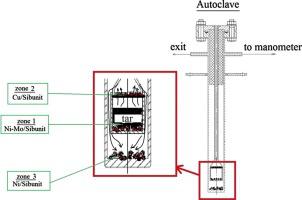Catalysis Today ( IF 5.2 ) Pub Date : 2020-08-27 , DOI: 10.1016/j.cattod.2020.08.002 Vladimir V. Chesnokov , Aleksandra S. Chichkan

|
The tar carbonization was studied in the temperature range of 350−500 °C. Gaseous products formed during the tar carbonization at 450 °C were analyzed for the concentration of sulfur-containing compounds. H2S and COS were observed in the reaction products. An increase of the carbonization temperature from 450 to 550 °C led to the decrease of the coke yield due to deeper cracking of the tar components. The temperature increases also resulted in the decrease of the sulfur concentration in the coke from 1.28 % to 1.18 %.
The efficiency of the carbonization process and the properties of the obtained coke were further improved by placing three different catalysts Ni-Mo/Sibunit, Cu/Sibunit and Ni/Sibunit in different zones of the autoclave where the tar carbonization was performed. In zone 1 the tar was subjected to hydrocracking and desulfurization over the 8%Ni-2,5%Mo/Sibunit catalyst. In zone 2 sulfur was trapped by the Cu/Sibunit catalyst in the form of copper sulfide. In zone 3 coke was formed over the Ni/Sibunit catalyst predominantly from gases formed by the tar cracking.
Such organization of the carbonization process increased the coke yield to 45 wt.%. The three-zone catalyst arrangement during the tar carbonization also resulted in a substantial decrease of the sulfur concentration in gaseous products, which led to lower sulfur concentration in the solid reaction products in zone 3.
中文翻译:

催化剂对焦油碳化的影响
在 350-500 °C 的温度范围内研究了焦油碳化。分析焦油在 450 °C 碳化过程中形成的气态产物的含硫化合物浓度。在反应产物中观察到H 2 S和COS。由于焦油组分的更深裂化,将碳化温度从 450°C 增加到 550°C 导致焦炭产率降低。温度升高还导致焦炭中的硫浓度从 1.28% 降低到 1.18%。
通过将三种不同的催化剂 Ni-Mo/Sibunit、Cu/Sibunit 和 Ni/Sibunit 放置在进行焦油碳化的高压釜的不同区域,进一步提高了碳化过程的效率和所得焦炭的性质。在区域 1 中,焦油在 8%Ni-2,5%Mo/Sibunit 催化剂上进行加氢裂化和脱硫。在区域 2 中,硫以硫化铜的形式被 Cu/Sibunit 催化剂捕获。在区域 3 中,主要由焦油裂解形成的气体在 Ni/Sibunit 催化剂上形成焦炭。
碳化过程的这种组织将焦炭产率提高到45重量%。焦油碳化过程中的三区催化剂布置也导致气态产物中硫浓度的显着降低,从而导致3区中固体反应产物中的硫浓度降低。

































 京公网安备 11010802027423号
京公网安备 11010802027423号